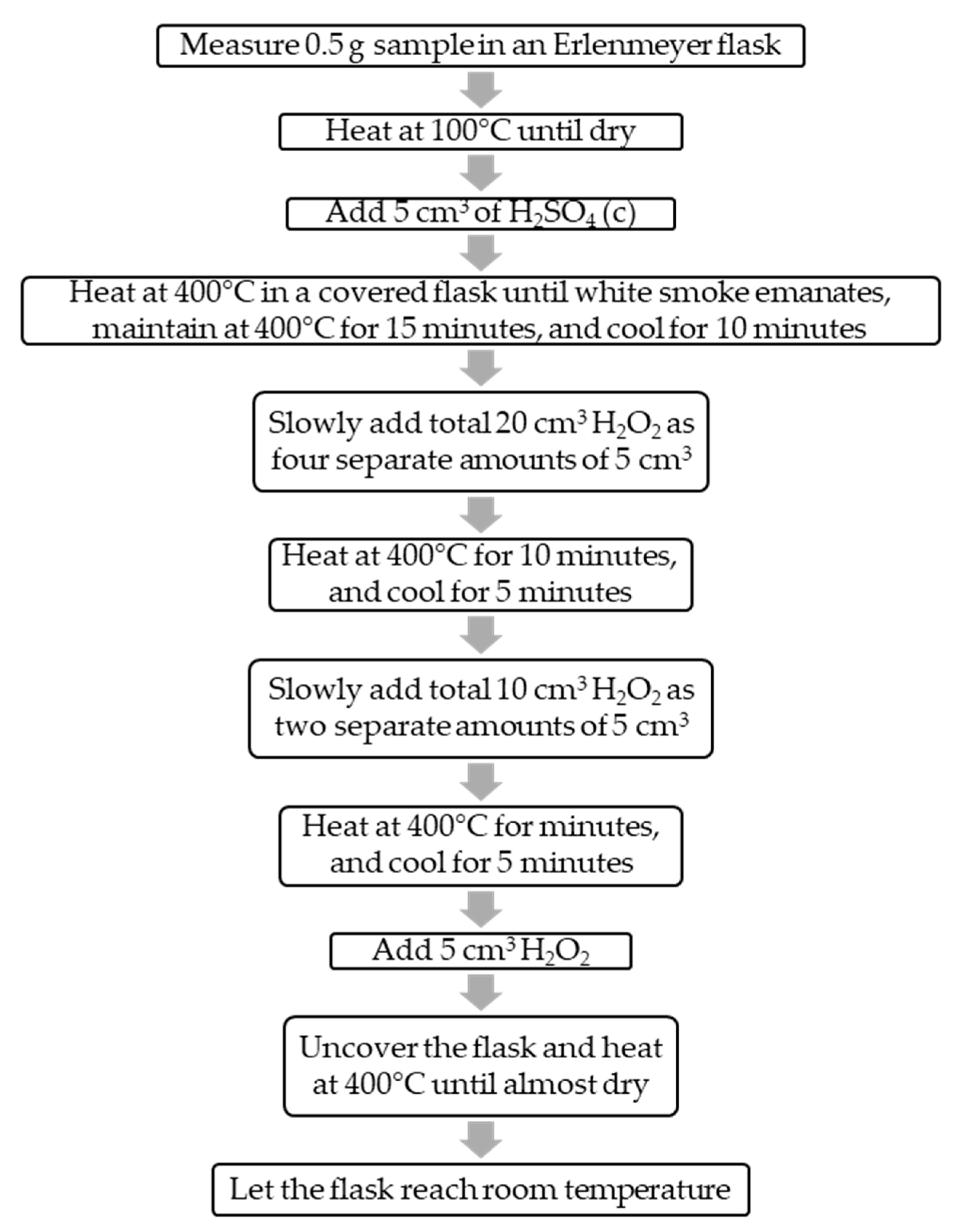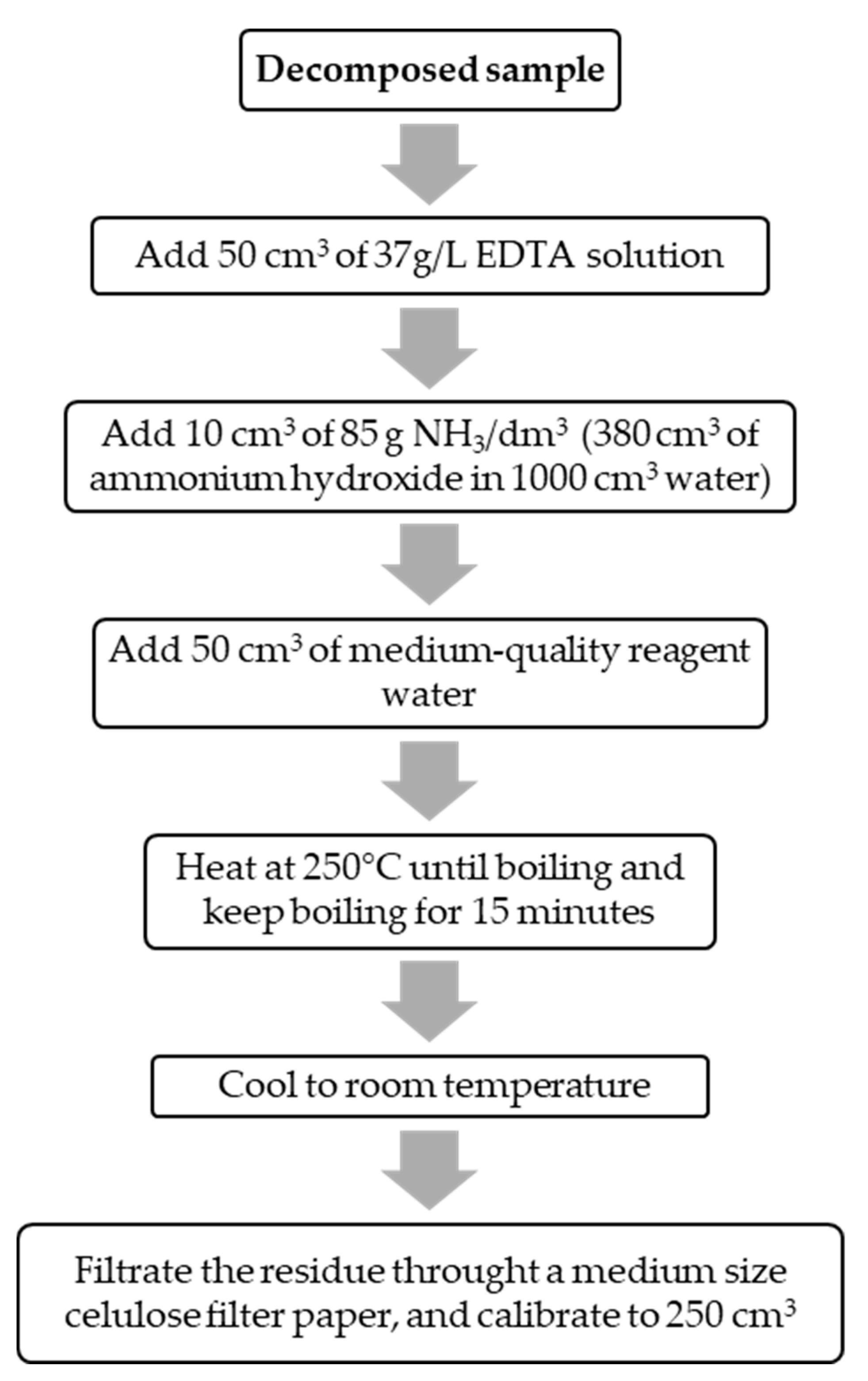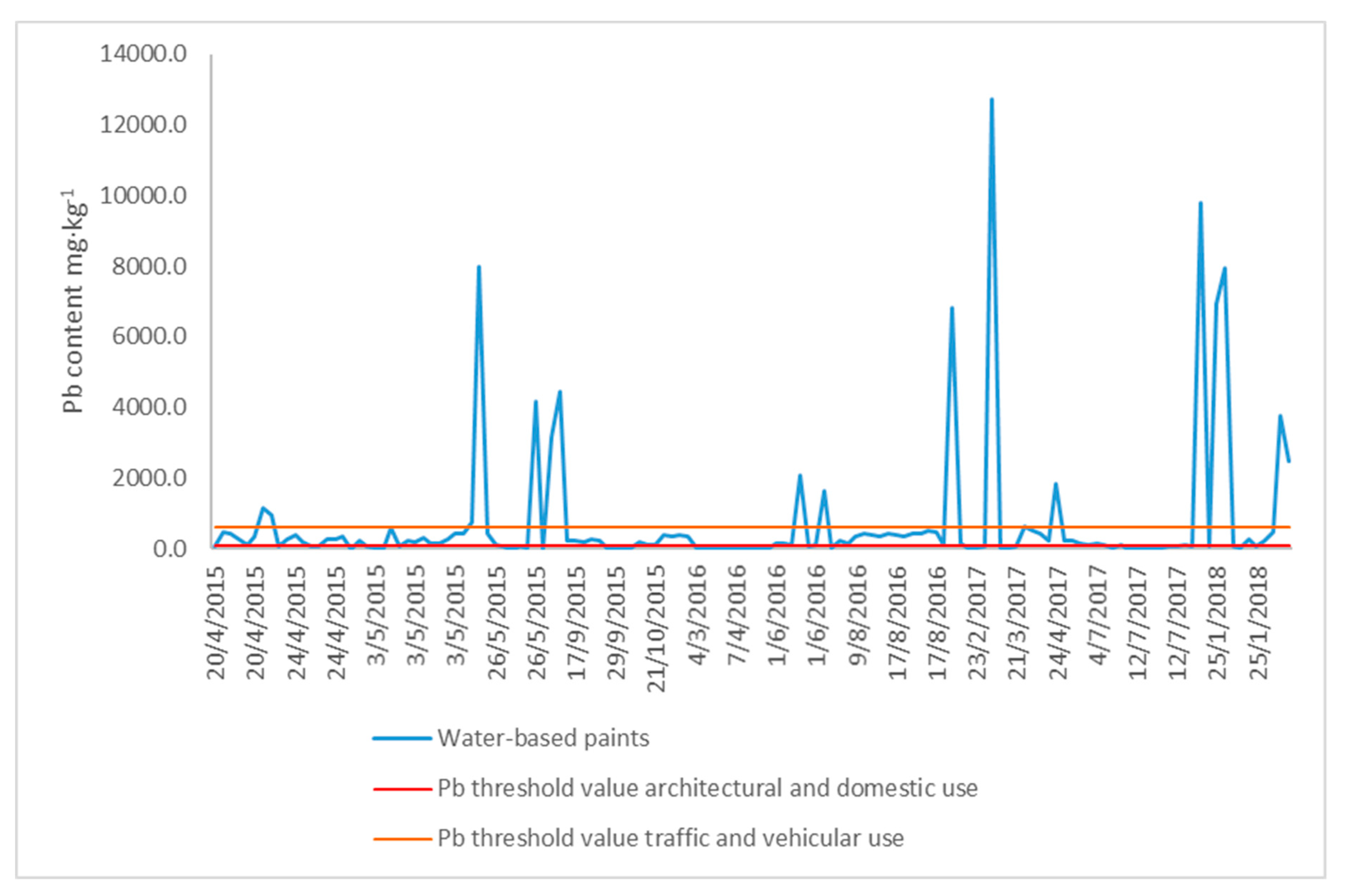Alkaline Extraction for Lead Determination in Different Types of Commercial Paints
Abstract
1. Introduction
2. Materials and Methods
- Initial calibration verification: within ±10% of the known value of the standard control.
- Initial calibration blank: an absolute value of no more than 20% of the LOQ value.
- Continuing calibration verification: within ±10% of the known value of the standard control.
- Continuing calibration blank: an absolute value of no more than 20% of the LOQ value.
- Matrix spike (fortifications): within ±25% of the known value.
- Triplicate sample: within ±25% of the RSD.
- Method blank: an absolute value of no more than 20% of the LOQ value.
3. Results
3.1. Method Validation
3.2. Pb Content of Paint Samples
4. Discussion
5. Conclusions
Author Contributions
Funding
Acknowledgments
Conflicts of Interest
References
- Ericson, B.; Hariojati, N.; Susilorini, B.; Fisher, L.; Fuller, R.; Patrick, M.; Caravanos, J. Assessment of the prevalence of lead-based paint exposure risk in Jakarta, Indonesia. Sci. Total Environ. 2019, 657, 1382–1388. [Google Scholar] [CrossRef] [PubMed]
- Gottesfeld, P. Toxic hypocrisy. New Sci. 2013, 218, 26–27. [Google Scholar] [CrossRef]
- ASTDR. ToxFAQs™-Plomo (Lead). 2016. Available online: https://www.atsdr.cdc.gov/es/toxfaqs/es_tfacts13.html (accessed on 2 September 2019).
- Berman, T.; Barnett-itzhaki, Z.; Reicher, S.; Ardi, R.; Shammai, Y.; Aruas, L.; Negev, M. Lead in spray paint and painted surfaces in playgrounds and public areas in Israel: Results of a pilot study. Sci. Total Environ. 2018, 637–638, 455–459. [Google Scholar] [CrossRef] [PubMed]
- Gottesfeld, P.; Pokhrel, D.; Pokhrel, A.K. Lead in new paints in Nepal. Environ. Res. 2014, 132, 70–75. [Google Scholar] [CrossRef] [PubMed]
- Hwang, Y.; Kate, C.; Lin, P. Globally temporal transitions of blood lead levels of preschool children across countries of different categories of Human Development Index. Sci. Total Environ. 2019, 659, 1395–1402. [Google Scholar] [CrossRef] [PubMed]
- WHO. Lead Poisoning and Health. 2018. Available online: https://www.who.int/news-room/fact-sheets/detail/lead-poisoning-and-health (accessed on 2 September 2019).
- O’Connor, D.O.; Hou, D.; Ye, J.; Zhang, Y.; Sik, Y.; Song, Y.; Coulon, F.; Peng, T.; Tian, L. Lead-based paint remains a major public health concern: A critical review of global production, trade, use, exposure, health risk, and implications. Environ. Int. 2018, 121, 85–101. [Google Scholar] [CrossRef] [PubMed]
- Clark, C.S.; Kumar, A.; Mohapatra, P.; Rajankar, P.; Nycz, Z.; Hambartsumyan, A.; Astanina, L.; Roda, S.; Lind, C.; Menrath, W.; et al. Examination of lead concentrations in new decorative enamel paints in four countries with different histories of activity in lead paint regulation. Environ. Res. 2014, 132, 233–243. [Google Scholar] [CrossRef] [PubMed]
- UNEP/IPEN. Lead in Enamel Decorative Paints National Paint Testing Results: A Nine Country Study. United Nations Environ. Program. 2013. Available online: http://wedocs.unep.org/handle/20.500.11822/22872 (accessed on 2 September 2019).
- ASTM. D3335-85a Standard Test Method for Low Concentrations of Lead, Cadmium, and Cobalt in Paint by Atomic Absorption Spectroscopy; ASTM International: West Conshohocken, PA, USA, 2014; pp. 1–4. [Google Scholar] [CrossRef]
- EPA. Pb-Based Paint Laboratory Operations Guidelines: Analysis of Pb in Paint, Dust, and Soil. Tech. Programs Branch. 1993. Available online: https://www.epa.gov/lead/pb-based-paint-laboratory-operations-guidelines-analysis-pb-paint-dust-and-soil-revision-10-epa (accessed on 2 September 2019).
- Greifer, B.; Maienthal, E.J.; Rasberry, S.D. Development of NBS Standard Reference Material: NO. 1579 Powdered Lead-Based Paint. 1973. Available online: https://trove.nla.gov.au/work/21688327?selectedversion=NBD415897 (accessed on 2 September 2019).
- Markow, P.G. Determining the Lead Content of Paint Chips: An Introduction to AAS. J. Chem. Educ. 1996, 73, 178–179. [Google Scholar] [CrossRef]
- Truman State University. Determination of Lead in Paint Chip Samples Using Flame Atomic Experimental Procedure: Part A—Sample Preparation: CHEM. 2015. Available online: http://chemlab.truman.edu/files/2015/07/Pblab.pdf (accessed on 2 September 2019).
- Clark, C.S.; Speranskaya, O.; Brosche, S.; Gonzalez, H.; Solis, D.; Kodeih, N.; Roda, S.; Lind, C. Total lead concentration in new decorative enamel paints in Lebanon, Paraguay, and Russia. Environ. Res. 2015, 138, 432–438. [Google Scholar] [CrossRef] [PubMed]
- ASTM. E1613-12: Standard Test Method for Determination of Lead by Inductively Coupled Plasma Atomic Emission Spectrometry (ICP-AES), Flame Atomic Absorption Spectrometry (FAAS), or Graphite Furnace Atomic Absorption Spectrometry (GFAAS) Techniques; ASTM International: West Conshohocken, PA, USA, 2012; pp. 1–9. [Google Scholar] [CrossRef]
- IOMC/WHO. Brief Guide to Analytical Methods for Measuring Lead in Paint, WHO Library Cataloguing-in-Publication Data. 2011. Available online: https://www.who.int/ipcs/assessment/public_health/lead_paint.pdf (accessed on 2 September 2019).
- Hobbs, A.L.; Almirall, J.R. Trace elemental analysis of automotive paints by laser ablation-inductively coupled plasma-mass spectrometry (LA-ICP-MS). Anal. Bioanal. Chem. 2003, 376, 1265–1271. [Google Scholar] [CrossRef] [PubMed]
- Gondal, M.A.; Nasr, M.M.; Ahmed, M.M.; Yamani, Z.H.; Alsalhi, M.S. Detection of lead in paint samples synthesized locally using-laser-induced breakdown spectroscopy. J. Environ. Sci. Health Part A 2011, 46, 42–49. [Google Scholar] [CrossRef] [PubMed]
- Lau, O.W.; Li, K.L. The Determination of Lead and Cadmium in Paint by Atomic-absorption Spectrophotometry Utilising the Delves Micro-Sampling Technique. Analyst 1975, 100, 430–437. [Google Scholar] [CrossRef]
- INEN. NTE INEN 2093:1998. Pinturas y productos afines. Determinación de plomo total método de espectrometría por absorción atómica. 1996. Available online: http://apps.normalizacion.gob.ec/descarga/ (accessed on 2 September 2019).
- ISO. ISO 6503:1984. Paints and Varnishes—DETERMINATION of Total Lead—Flame Atomic Absorption Spectrometric Method. 1984. Available online: https://www.iso.org/standard/12880.html (accessed on 2 September 2019).
- McBride, M.B.; Goodman, B.A.; Russell, J.D.; Fraser, A.R.; Frame, V.C.; Dickson, D.P.E. Characterization of iron in alkaline EDTA and NH4OH extracts of podzols. J. Soil Sci. 1983, 34, 825–840. [Google Scholar] [CrossRef]
- Ntumba Malenga, E.; Mulaba-Bafubiandi, A.F.; Nheta, W. Alkaline leaching of nickel bearing ammonium jarosite precipitate using KOH, NaOH and NH4OH in the presence of EDTA and Na2S. Hydrometallurgy 2015, 155, 69–78. [Google Scholar] [CrossRef]
- Karczewska, A.; Milko, K. Effects of Chelating Agents on Copper, Lead and Zinc Solubility in Polluted Soils and Tailings Produced by Copper Industry. Ecol. Chem. Eng. A 2010, 17, 395–403. [Google Scholar]
- Ding, Z.; Wang, Q.; Hu, X. Extraction of Heavy Metals from Water-Stable Soil Aggregates Using EDTA. Procedia Environ. Sci. 2013, 18, 679–685. [Google Scholar] [CrossRef][Green Version]
- INEN. NTE INEN 1544:2018. Pinturas Arquitectónicas. Pinturas en Emulsión base Agua (LATEX). Requisitos. 2018. Available online: http://apps.normalizacion.gob.ec/descarga/ (accessed on 2 September 2019).
- INEN. NTE INEN 2284:2018. Pinturas. Lacas Catañizadas al ácido para Acabados sobre Madera. Requisitos. 2018. Available online: http://apps.normalizacion.gob.ec/descarga/ (accessed on 2 September 2019).
- INEN. NTE INEN 2095:2017. Pinturas. Esmaltes Alquídicos Modificados para Vehículos. Requisitos. 2017. Available online: http://apps.normalizacion.gob.ec/descarga/ (accessed on 2 September 2019).
- INEN. NTE INEN 1042:2009. Pinturas para señalamiento de tráfico. Requisitos. 2009. Available online: http://apps.normalizacion.gob.ec/descarga/ (accessed on 2 September 2019).
- INEN. NTE INEN 2094:2013. Pinturas. Esmaltes alquídicos sintéticos para uso doméstico. Requisitos. 2013. Available online: http://apps.normalizacion.gob.ec/descarga/ (accessed on 2 September 2019).
- INEN. NTE INEN 1043:2001. Pinturas. Imprimantes anticorrosivos con vehículo alquídico. Requisitos. 2001. Available online: http://apps.normalizacion.gob.ec/descarga/ (accessed on 2 September 2019).
- INEN. NTE INEN 1044:2001. Pinturas. Recubrimientos anticorrosivos para altas temperaturas. Requisitos. 2001. Available online: http://apps.normalizacion.gob.ec/descarga/ (accessed on 2 September 2019).
- INEN. NTE INEN 2287:2001. Pinturas. Masillas nitrocelulósicas y de poliester. Requisitos. 2001. Available online: http://apps.normalizacion.gob.ec/descarga/ (accessed on 2 September 2019).
- INEN. NTE INEN 1616:1987. Pinturas para señalamiento de tránsito en aeropuertos. Requisitos. 1987. Available online: http://apps.normalizacion.gob.ec/descarga/ (accessed on 2 September 2019).
- INEN. NTE INEN 1045:1983. Pintura anticorrosiva esmalte alquídico brillante. Requisitos. 1983. Available online: http://apps.normalizacion.gob.ec/descarga/ (accessed on 2 September 2019).
- INEN. NTE INEN 1046:2001. Pinturas. Imprimantes anticorrosivos con vehículo epóxico. Requisitos. 2001. Available online: http://apps.normalizacion.gob.ec/descarga/ (accessed on 2 September 2019).
- INEN. NTE INEN 2280:2001. Pinturas. Lacas nitrocelulósicas para repintado de vehículos. Requisitos. 2001. Available online: http://apps.normalizacion.gob.ec/descarga/ (accessed on 2 September 2019).
- INEN. NTE INEN 2281:2001. Pinturas. Lacas acrílicas para repintado de vehículos. Requisitos. 2001. Available online: http://apps.normalizacion.gob.ec/descarga/ (accessed on 2 September 2019).
- INEN. NTE INEN 2282:2001. Pinturas. Sellador nitrucelulósico lijable para madera. Requisitos. 2001. Available online: http://apps.normalizacion.gob.ec/descarga/ (accessed on 2 September 2019).
- INEN. NTE INEN 2283:2001. Pinturas. Lacas nitrocelulósicas para acabados sobre madera. Requisitos. 2001. Available online: http://apps.normalizacion.gob.ec/descarga/ (accessed on 2 September 2019).
- INEN. NTE INEN 2285:2001. Pinturas. Barnices alquídicos de secamiento al aire. Requisitos. 2001. Available online: http://apps.normalizacion.gob.ec/descarga/ (accessed on 2 September 2019).
- INEN. NTE INEN 2286:2001. Pinturas. Fondos nitrocelulósicos para repintado en la industria automotríz. Requisitos. 2001. Available online: http://apps.normalizacion.gob.ec/descarga/ (accessed on 2 September 2019).



| Paint Product | Number of Samples | Pb Concentrations | RSD | Fortification Recovery Rates | ||||||
|---|---|---|---|---|---|---|---|---|---|---|
| Minimum Value | Maximum Value | Mean Value | Minimum Value | Maximum Value | Mean Value | Minimum Value | Maximum Value | Mean Value | ||
| water-based 1 | 135 | < LOD | 12,715.3 | 738.4 | 0.0% | 14.8% | 4.7% | 80.8% | 119.2% | 101.1% |
| solvent-based | 38 | < LOD | 10,502.9 | 1316.7 | 0.0% | 13.7% | 4.7% | 80.4% | 119.4% | 101.4% |
| epoxy | 5 | 16.2 | 3081.7 | 1167.8 | 0.7% | 11.6% | 4.7% | 83.9% | 114.1% | 100.2% |
| alkyd enamels 2, 3 | 4 | 172.8 | 727.7 | 447.0 | 0.9% | 8.1% | 5.0% | 82.2% | 108.7% | 97.0% |
| synthetic enamels | 40 | < LOD | 21,044.5 | 5578.5 | 0.0% | 13.4% | 2.8% | 80.3% | 119.3% | 101.7% |
| lacquers 1 | 2 | 483.4 | 826.5 | 654.9 | 4.7% | 6.0% | 5.3% | 94.0% | 109.0% | 101.5% |
| putties | 5 | < LOD | 98.5 | 37.1 | 0.0% | 12.4% | 5.6% | 94.7% | 109.3% | 103.4% |
| pure pigments | 9 | < LOD | 145.1 | 33.1 | 0.0% | 11.4% | 3.7% | 92.0% | 118.4% | 101.4% |
| preformed thermoplastics 2 | 8 | < LOD | 77.0 | 20.9 | 0.0% | 2.7% | 1.6% | 86.6% | 107.1% | 97.9% |
| resins | 4 | 4.6 | 189.9 | 124.4 | 0.8% | 10.8% | 7.4% | 102.0% | 115.9% | 107.4% |
| TOTAL | 250 | 4.6 | 21,044.5 | 1011.9 | 0.0% | 14.8% | 4.6% | 80.3% | 119.4% | 101.3% |
© 2019 by the authors. Licensee MDPI, Basel, Switzerland. This article is an open access article distributed under the terms and conditions of the Creative Commons Attribution (CC BY) license (http://creativecommons.org/licenses/by/4.0/).
Share and Cite
Romero-Estévez, D.; Yánez-Jácome, G.S.; Simbaña-Farinango, K.; Vélez-Terreros, P.Y.; Navarrete, H. Alkaline Extraction for Lead Determination in Different Types of Commercial Paints. Methods Protoc. 2019, 2, 84. https://doi.org/10.3390/mps2040084
Romero-Estévez D, Yánez-Jácome GS, Simbaña-Farinango K, Vélez-Terreros PY, Navarrete H. Alkaline Extraction for Lead Determination in Different Types of Commercial Paints. Methods and Protocols. 2019; 2(4):84. https://doi.org/10.3390/mps2040084
Chicago/Turabian StyleRomero-Estévez, David, Gabriela S. Yánez-Jácome, Karina Simbaña-Farinango, Pamela Y Vélez-Terreros, and Hugo Navarrete. 2019. "Alkaline Extraction for Lead Determination in Different Types of Commercial Paints" Methods and Protocols 2, no. 4: 84. https://doi.org/10.3390/mps2040084
APA StyleRomero-Estévez, D., Yánez-Jácome, G. S., Simbaña-Farinango, K., Vélez-Terreros, P. Y., & Navarrete, H. (2019). Alkaline Extraction for Lead Determination in Different Types of Commercial Paints. Methods and Protocols, 2(4), 84. https://doi.org/10.3390/mps2040084





